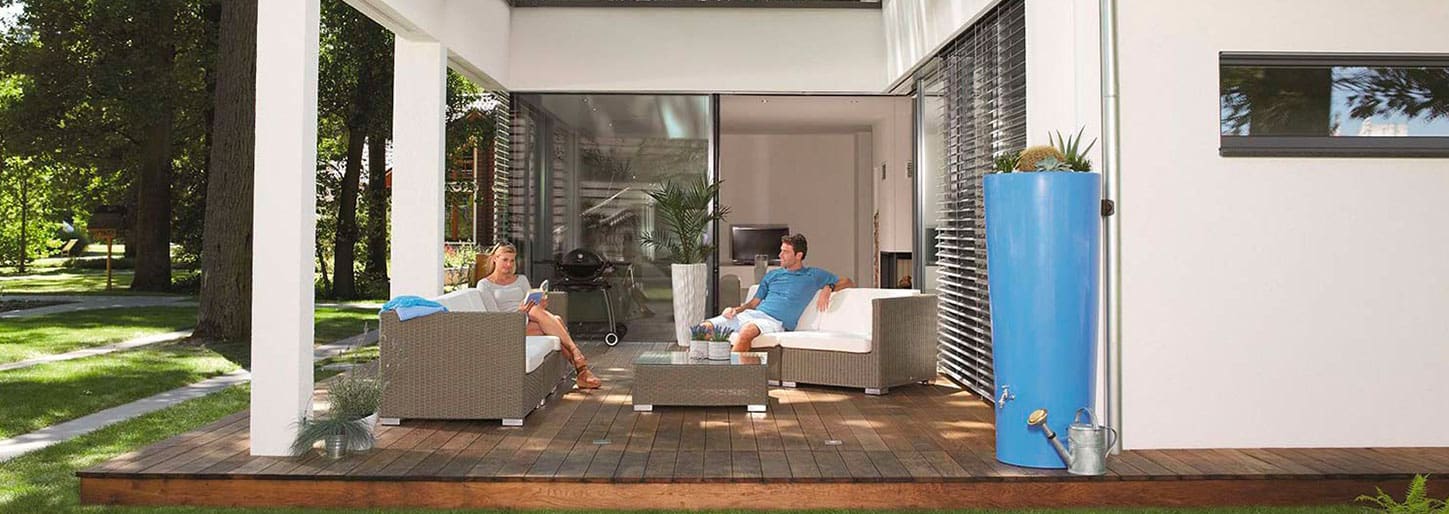
Water is a precious element that is becoming increasingly scarce on our planet. While water consumption continues to increase, freshwater resources are certainly not on the rise. Worse: they are in danger of depletion.
60% of the French territory suffers from a lack of fresh water. Though it does rain often, only 11% of the rainwater fills our groundwater tables! The rest evaporates or runs off… The answer? The rainwater collector, one of the most eco-friendly and economical solutions for your home. Drinking water is expensive (currently priced at €3.00 per m3 on average) and its cost is continually increasing. Above all, what is essential to know is that 60% of the consumed water is destined for purposes that do not necessarily require drinking water. Using rainwater is synonymous with short-term cost-effectiveness and brings added value to your home. Since a rainwater tank can collect up to 80 to 90% of the rainwater that falls on the roof, a family of 4 people can expect to save more than 40% of its water consumption (about €300 per year), without having to restrict its own daily use (150 to 200 liters on average).
A degree of independence!
Don’t worry about French prefectural decrees regarding water use. Though they prohibit or limit certain water uses (washing vehicles, watering lawns, vegetable gardens, flower beds, filling swimming pools…), all this becomes possible with rainwater harvesting! Besides, rainwater has a slightly acidic pH, which plants and vegetables particularly appreciate.
Here’s a selection of good rainwater harvesting tanks available in French retail stores :
- 7-liter Rainwater tank/watering can, priced at 17,30 euros at Point Vert
- 275-liter Wall tank, sold for 99 euros at Truffaut
- 235-liter rainwater jar, sold for 149 euros at Botanica
- 350-liter Wooden wall rainwater tank, available at Castorama for 339 euros
- 350-liter Rainwater tank, available at Bricomarché for 379 euros
Who said “Ecology” wasn’t synonymous with “Savings”?
Finding the rainwater tank that best suits your needs
If you plan to use rainwater for gardening purposes only, an outdoor rainwater tank will suffice. The container can be installed outside your house or in a crawl space. It is a simple and efficient solution. You’ll find a wide range of rainwater tanks on the market, each with a more or less attractive aesthetic design, and with different capacities adapted to your needs (up to 10,000 liters). Rainwater falls on the roof and is channeled via the gutters, which are directly connected to the tank. It’s best to opt for PVC, zinc or earthenware gutters. Slate or tile roofs allow for a purer water harvesting than aluminum or synthetic roofs. If you intend to reuse rainwater for domestic purposes (for example, for the washing machine or the toilets), you will need an underground tank (if possible, set-up at the edge of your house’s construction site). Before being pipelined by the pump to the house, the water will be filtered, but be careful: it will not be safe to drink or used for personal hygiene. For example, here are the quantities of water you would need for:
- watering of a garden/vegetable garden of less than 50 m²: 150 to 500 liters
- watering of a garden/vegetable garden of less than 100 m² ≈ 500 to 1500 liters
- watering a garden and washing a car: 1500 to 3000 liters
- watering a garden, washing a car and filling a pool: 3000 to 5000 liters: 3000 à 5000 L
- garden-watering and domestic uses: 6000 to 9000 liters
Set-up, maintenance, and cost
Setting up a tank is quick and straightforward. You must set-up your rainwater tank near the downspout, and you can even install it directly in a barrel, a large basin, or a container. It is still strongly recommended to use a rainwater harvesting system directly installed inside the gutter. Some are equipped with filters; otherwise, it is sufficient to place grids on the gutter to collect water purer and free of dirt (leaves, insects…) that would alter the quality of the water. Finally, remember to cover the tank to avoid the formation of algae. This will make your water cleaner. During winter, store your tank in a sheltered place, as cold and freezing temperatures could damage it. This problem does not concern underground tanks: you can use them all year long! Cost-wise, while you will pay an average of fifty euros for “basic” tanks, a more pleasantly designed and French-made tank will cost between 200 to 400 euros. An underground tank will cost about 5,000 to 8,000 euros (depending on the equipment, the price of labor, the complexity of the site, etc.)
Good to know:
Since 2014, it is no longer possible to obtain a tax credit for the installation of a rainwater harvesting system. However, some municipalities do subsidize the installation of this type of equipment. Contact your département and/or your municipality. It is also possible to benefit from a reduced VAT rate of 10% (provided that the equipment is intended for a primary residence whose construction has been completed for more than two years). The following service providers can assist you: Aquavalor, Forte Water, Aquality…


